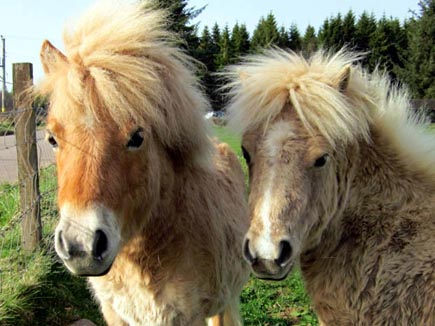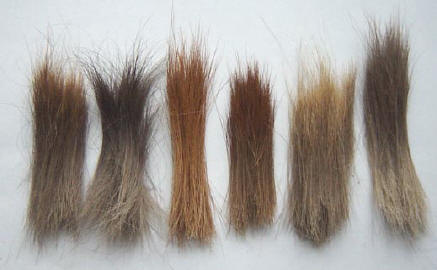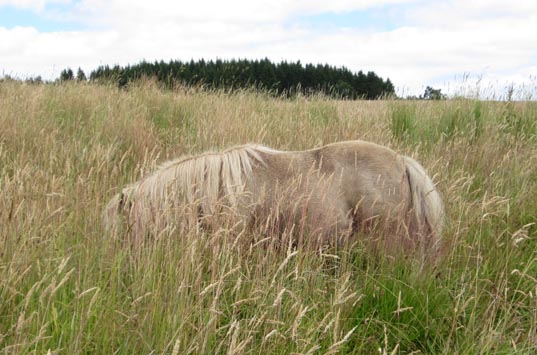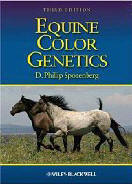|
Mushroom - a
Recently
Recognised
Dilution The genetic cause of the mushroom colour has been found by Dr Rebecca Bellone & Jocelyn Tanaka at U.C. Davis, California. They have now developed the long awaited DNA test for mushroom so breeders have the opportunity to find out whether their ponies may carry this gene.
Further details can be found at:
http://www.vgl.ucdavis.edu/services/horse/MushroomDilution.php |
|
|
|
|
| Mushroom is now regarded as an established
& recognised colour variation in Shetland ponies from UK bloodlines. As
yet, it has not been proved in any other breed. It is not a new colour.
There is evidence in the old Shetland Pony Stud-Book Society stud-books to
show that it has been in the breed since the Society began to record
pedigrees of Shetland ponies in 1890. There are several ponies registered in past UK Shetland Pony Stud-Book Society volumes that may have been mushroom. In the first volume a mare, Berghita 101, foaled in 1885, was registered as "Brown with silver points". In 1893, a filly, Unornia II, was born to a black mare, Guddonia II 1226 & the stallion, Triptolemus 45, bay with black points. Unornia was registered as "Brown, whitish mane & tail". She retained this colouring when registered as a mare (reg. no.1313) in 1898. More recently, the Avening Stud had several foals described as "dun" from chestnut parents. Avening Festina (born 1951) was "silver, flaxen mane & tail" from chestnut parents. Ponies from other studs have been registered as "cream" with two chestnut parents. Many of the present mushroom coloured ponies have now been DNA tested to find out if they might be genetically silver but have proved to be negative for this gene. They have all proved to be chestnut based & breed as one would expect of chestnut ponies. The mushroom colour appears to be a variation in chestnut & a recessive gene so only occurs when two ponies that carry the gene are mated. It can be carried unseen for a number of generations so coming as a surprise to breeders when a mushroom foal is born unexpectedly. Recognition In the expansion of my Shetland pony herd, I purchased several ponies. Among these were a cream chestnut dun stallion, Firth Honeyclover and a cream chestnut dun filly, Grimpowood Tammy. The first foal from this pair, initially appeared to be a pale cream chestnut dun filly, but as she coated out, she became much paler in colour, almost resembling a cream foal. The following year, a chestnut mare of my own breeding produced a foal by Honeyclover that appeared palomino. A palomino was impossible, there being no crème gene in the pedigree at all. More of these foals followed over the years and I began to research the colour more thoroughly. Letters, photos & hair samples were sent to acknowledged authorities
all over the world but no-one could tell me what this colour was.
Suggestions were put forward but none seems to fit the results from my own
herd which bred as one would expect of chestnut ponies. |
|
|
|
|
| Mushroom Colouring. So, what are the characteristics of this colour? The foals I have bred, have been pale at birth, some a pale beige, some more fawn with a greyish or pinkish tint but unlike any other colour seen in Shetland foals. The mane & tail are usually the same colour as the body. Birth colour varies in how dark it may be but does not have any hint of the redness seen in a chestnut based foal. Lower legs are usually very pale in colour & hooves may be white at birth. They appear to have blue-grey eyes at birth which change to brown over the following months in common with those of other dilutions such as dun or palomino. Foal colour may darken or lighten & the true shade of the colour may not become apparent until the following year. A mushroom coloured foal may be born from any colour of parent. Similar foals have been registered by other breeders as "grey", "dark chestnut", "roan" or "cream". The pedigrees & photographs show that the foals are none of these.
Adult colour. Mushroom must not be confused with cream chestnut dun or chestnut dun which have a yellow or orange tint to the coat. The important part of identification is the absence of any hint of red in the coat. The coats all have a rather faded look as opposed to the intense, shiny colour of the normal base colour coat. It is as if someone has removed all the red from the colour pigment. The darker mushrooms sometime show creamy ends to the long guard hairs & pony's beard. The skin colour of my own mushrooms seems to be mainly grey in colour. In some, there is a degree of mottling around the dock area but nothing really unusual. Many of these mushrooms have flaxen manes & tails &, in the dun forms, the eel stripe is sometimes missing from the mane & tail, although present as a liver dorsal stripe. However, there are some darker mushrooms that have darker manes & tails that have silver hairs through them. They seem to vary greatly in the same way that shades of chestnut vary from a pale red to a dark liver shade. An equine vet has looked at the eyes of some of my mushrooms. So far, they appear to lack pigment at the back of the eye, so their eyes resemble the eyes of a chocolate Labrador dog. Note. Mushroom may be found in dun, roan or pied combinations. In the dun form, the dorsal stripe is usually a liver colour. I researched some of the more common lines where these foals
appear & give some examples on the following pages. Some lines are
chestnut bred for several generations with no unexpected bays or browns
(as would be expected if the silver gene was present). Other mushrooms
have appeared from a black to black mating. All appear sporadically
& in low numbers, a mare perhaps only producing one in a life time
depending on whether the stallion used carries the mushroom gene or not.
Breeding mushroom to mushroom has produced mushroom coloured foals only.
The recent research carried out by Dr. Rebecca Bellone shows that
homozygous (2 copies of the gene) mushroom appears as mushroom colour in a
chestnut base pony. Heterozygous (1 copy of the gene) does not usually
show in a pony. |
|
| All of my mushroom ponies were red factor tested the result for
all proved they are chestnut base
colour. All of my mushroom ponies were tested were tested for silver &
they all proved negative for the silver
gene. Since then, many other mushroom Shetlands have been tested for red &
silver. All have proved to be red but
negative for silver.
|
|
|
WARNING TO BREEDERS. Breeders of purebred Shetland ponies should be aware that a stallion, Luxus, has been tested as positive for the dominant silver gene. Silver has never been found in Shetland ponies of UK parentage. Luxus was bred in Germany & has a recognised paternal line that traces to UK breeding but his maternal line traces through few generations of unknown ponies from unknown origins & with no apparent lines tracing to UK stud-books. It is most regrettable that any breeder should wish to bring outside blood into an ancient & pure breed but foals from this stallion are now in Denmark & Sweden. Most Shetland pony breeders will undoubtedly wish to maintain pure Shetland pony bloodlines so should be aware that some ponies with the silver gene can mimic the mushroom colour. Breeders should also be aware that silver is carried unseen by chestnut or chestnut base ponies. If there is any doubt, there is a simple DNA test that can determine whether a pony is genetically silver or carries the silver gene. The silver gene has been identified as being connected with a particularly nasty eye problem, Anterior Segment Disorder (ASD), also known as Multiple Congenital Ocular Anomalies Syndrome (MCOAS). Heterozygous silver-coloured equines have eye cysts & may be myopic while homozygous silver shows cysts & severe deformities of the eye. |
|
| So far, we can only be sure of recognising the colour in mushroom coloured ponies. Some bay Shetlands, homozygous for mushroom, resemble buckskins but have no crème dilution in their parentage. A lot more will be learned about this dilution when more ponies have been tested for the presence of mushroom in mushroom carrying ponies that are not themselves mushroom in colour. It is important that breeders ensure that a foal's registered colour makes it clear that this is not a normal chestnut or crème dilute if great confusion is to be avoided in years to come. It is also important to remember that all the research into mushroom coloured ponies has been done on registered Shetland ponies with UK origins & their descendants only. | |
|
|
|
|
|
|
|
|
EQUINE COLOR GENETICS Note: A chapter on the mushroom colour, giving more details, is given in Professor Sponenberg's book "Equine Color Genetics", published in February 2009. This book should be obtainable through Amazon.co.uk or other on-line book stores. |
|
Text & photographs on all Mushroom pages are copyright of Beth Mead unless otherwise stated
|
|
|
|
|




